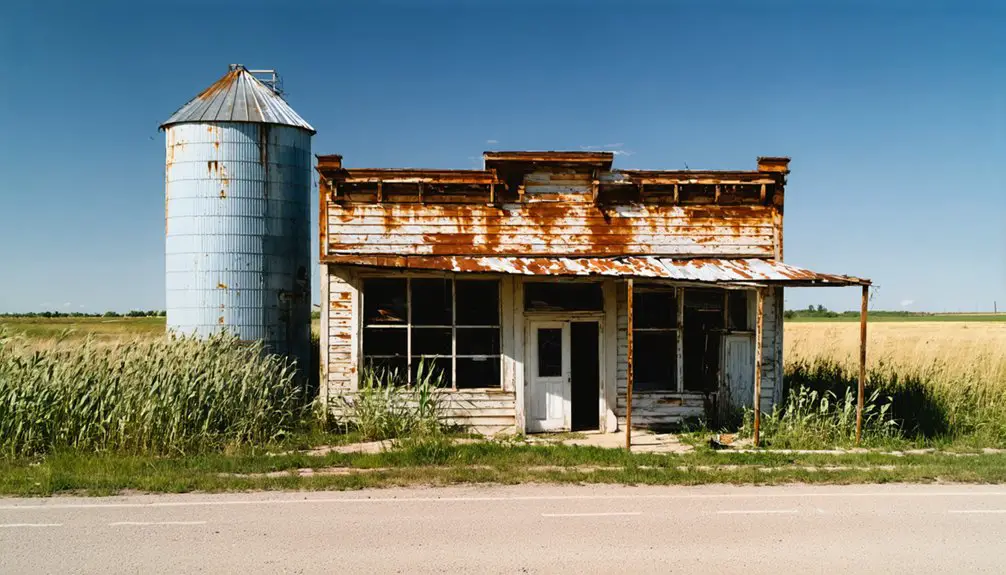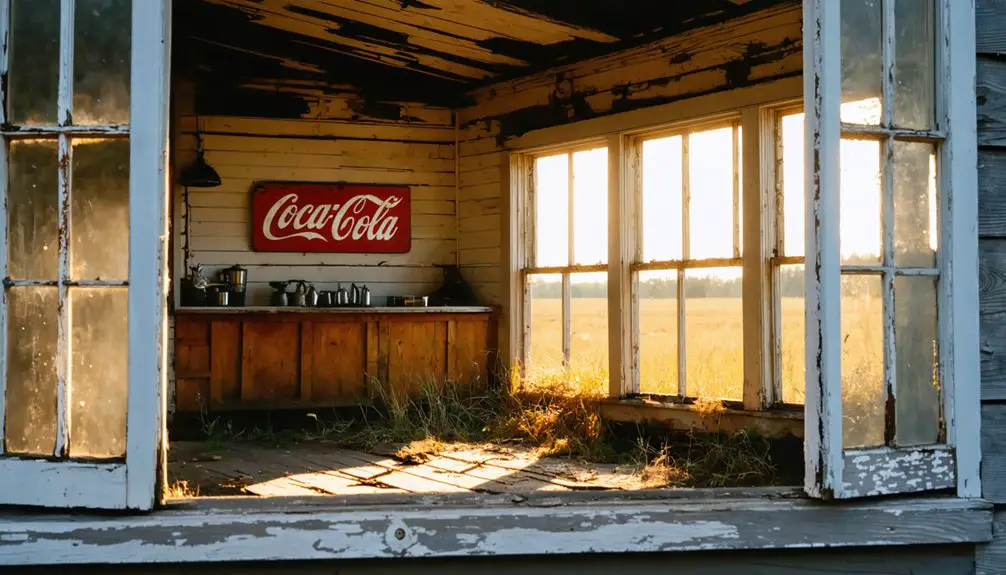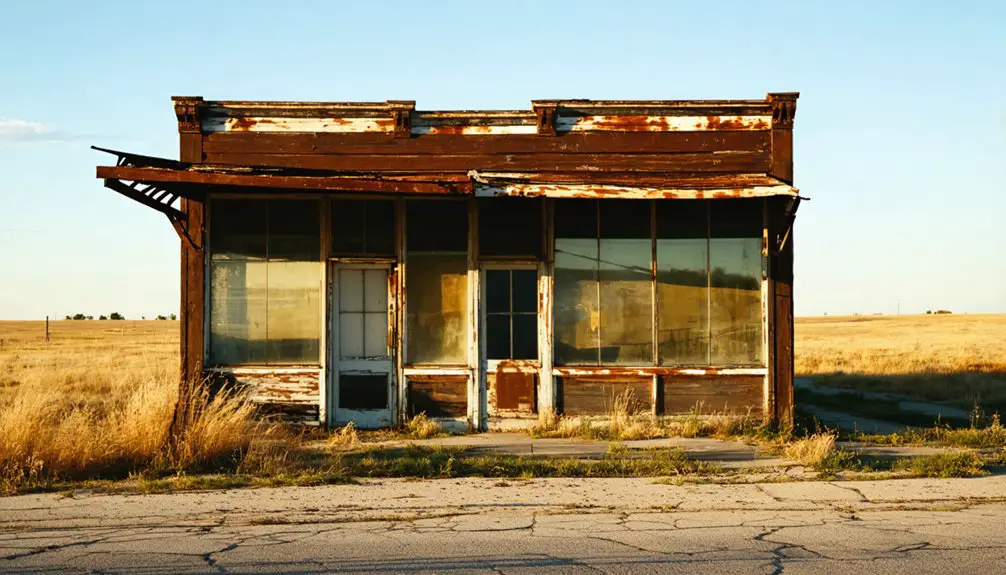You’ll find Centerview’s ghost town remains seven miles west of Warrensburg, Kansas, where it once thrived as an agricultural community established in 1874. The town’s post office, opened in 1917, served as its economic hub for over 40 years until closing in 1959. Today, empty storefronts, abandoned buildings, and aging grain elevators stand as silent witnesses to a population that dwindled from 300 residents in 1940 to fewer than 50 by 1970. Its story mirrors thousands of Kansas prairie towns that time left behind.
Key Takeaways
- Centerview was established in Edwards County, Kansas, in 1874, named after pioneer W.C. Edwards and originally called Graham in 1865.
- The town’s post office operated from 1917 to 1959, with its closure marking the beginning of significant economic decline.
- Population dropped drastically from over 300 residents in 1940 to fewer than 50 by 1970, making it a ghost town.
- Located seven miles west of Warrensburg, the town was primarily agricultural before mechanization and market changes led to abandonment.
- Empty storefronts, decaying buildings, and an abandoned brick high school remain as evidence of Centerview’s historical significance.
The Rise of a Rural Community
While many Kansas settlements emerged during the late 19th century, Centerview took root in Edwards County as part of the region’s broader agricultural expansion.
Similar to nearby communities like Cedar Point, the town established key services to support local residents.
You’ll find the community’s establishment aligning with Edwards County’s founding in 1874, named after pioneer W.C. Edwards.
The region’s community dynamics centered around farming and ranching, with early settlers facing agricultural challenges as they carved out their livelihoods from the Kansas prairie.
Like Bell Plane’s early residents who purchased land for 1.25 per acre, settlers in Centerview sought affordable opportunities to establish their homesteads.
Post Office Legacy and Economic Activity
Centerview’s economic heartbeat found its rhythm in 1917 with the establishment of a post office that would serve the community for over four decades.
You’ll find that this hub of communication played a crucial role in shaping the town’s economic legacy, facilitating trade and connecting local businesses to external markets.
As you explore Centerview’s history, you’ll discover how the post office created jobs and spurred infrastructure development until its closure in 1959.
The town was actually established as Graham in 1865 before adopting its current name.
Located seven miles west of Warrensburg, the agricultural foundation of the area supported the community’s growth, while the post office served as a central gathering point for residents and merchants alike.
Though specific businesses aren’t documented, the post office’s 42-year run demonstrates the town’s resilience and economic importance during the early-to-mid 20th century.
Signs of Decline and Abandonment
You’ll find evidence of Centerview’s decline in its closed post office, which served as a crucial economic hub before shuttering its doors.
The town’s population steadily dwindled over the decades as residents moved away in search of better opportunities, leaving behind increasingly vacant homes and businesses. Like many Kansas ghost towns, loss of commerce triggered the community’s abandonment. Kansas history shows an astonishing dead towns count of over 6,000 across the state.
Today, empty buildings stand as silent witnesses to Centerview’s transformation from a once-active community into a ghost town.
Post Office Closure Impact
In 1959, the closure of Centerview’s post office marked a critical turning point in the town’s decline, removing an essential hub for communication and daily social interaction.
You’ll find this loss dealt a severe blow to local connectivity, forcing residents to travel to neighboring towns for basic postal services they’d once enjoyed within walking distance.
The closure’s impact rippled through the community’s social fabric, severing daily gathering spots where neighbors would exchange news and greetings.
Without the post office, you’d see fewer chances for spontaneous meetings and community bonding. The building’s emptiness became a visible symbol of Centerview’s fading autonomy and relevance. The town’s closure was documented in the postal service records requiring specific date formats for all discontinued offices.
Since no comprehensive records exist of all U.S. post offices that ever operated, researching Centerview’s postal history requires examining state-specific books and regional documentation.
This shutdown accelerated the town’s deterioration by discouraging new residents and businesses while pushing existing inhabitants, especially elderly ones, to relocate to areas with better services.
Population Loss Over Time
Between 1940 and 1970, the population of Centerview plummeted from over 300 residents to fewer than 50, reflecting broader economic shifts that devastated rural Kansas communities.
You’ll find this demographic trend mirrored the fate of many small towns across the state, where mechanized farming and industrial decline severely impacted community resilience.
As younger residents moved to urban centers seeking better opportunities, Centerview’s remaining population aged greatly.
Today, homes in towns like Centerview sell for under $75,000, making them significantly more affordable than properties in thriving communities.
Similar to Empire City’s fate in the 1880s when lead deposits diminished, Centerview saw its economic foundation crumble.
You can see the impact of this exodus in abandoned buildings, closed businesses, and deteriorating infrastructure.
The town’s social fabric unraveled as community events dwindled and essential services became harder to maintain.
Without a strong economic base or sufficient population to support local businesses, Centerview’s decline accelerated, making it increasingly difficult to attract new residents or investment.
Empty Buildings Remain Today
Today’s visitors to Centerview encounter stark evidence of the town’s decline through its remaining structures.
You’ll find empty storefronts and decaying buildings that hint at the community’s historical significance. The brick high school, though crumbling, stands as a symbol of busier times, while abandoned homes dot the landscape, most in various states of collapse.
The most prominent features you’ll spot are the aging grain elevators and silos, robust remnants of Centerview’s agricultural heritage.
While some churches and their adjacent cemeteries receive minimal upkeep, nature has reclaimed much of the town’s infrastructure.
Street signs mark phantom roads now hidden beneath grass and vegetation, and former railroad tracks exist only as faint traces in the terrain, telling the story of a once-thriving Kansas community.
Modern Remnants and Physical State

While Centerview’s ghost town site remains accessible via rural dirt roads, visitors will find minimal evidence of its former existence.
During remnants exploration, you’ll discover the physical landscape has been largely reclaimed by native prairie grasses and shrubs. You’ll spot scattered foundational stones, basement pits, and occasional rusted metal fragments where buildings once stood.
You won’t find any standing structures or informative markers to guide your visit. The site requires careful observation to detect subtle traces of the past, as soil erosion and dense vegetation obscure many remaining features.
Small artifacts like broken glass, ceramic shards, and corroded nails occasionally surface, offering glimpses into early 20th-century rural life. Without formal preservation efforts, these remnants continue to fade into the surrounding Kansas prairie.
Edwards County’s Rural Transformation
When you examine Edwards County’s population patterns from its 1874 founding through today, you’ll notice the dramatic shifts from early growth spurts – like the jump from 301 to 633 residents in 1874 – to the gradual emptying of farmlands.
You can track how individual townships that once bustled with activity, such as Brown Township’s 360 residents in 1880, have transformed as agricultural practices modernized and consolidated.
The county’s evolution from small subsistence farms to today’s larger commercial operations illustrates the broader story of rural transformation, where fewer farmers now work more land.
Population Shifts Over Time
Over the past century, Edwards County has experienced a dramatic population decline that mirrors the broader transformation of rural Kansas.
You’ll find the county’s demographic challenges reflected in its population drop from 3,768 residents in 1910 to just 1,422 by 2020 – a staggering 62% decrease.
The county’s community resilience is being tested by these key population shifts:
- Annual population decline averaging 0.9% between 2010-2022
- Median age of 44.3 years, considerably higher than Kansas’s 36.5
- Continued outmigration of working-age residents
- Growing proportion of residents aged 65 and over
- Population density falling to just 0.67 persons per square mile
This transformation has reshaped the county’s social fabric, with remaining residents increasingly concentrated in small towns while outlying areas become sparsely inhabited.
From Farms to Fallowland
As the Great Depression and Dust Bowl devastated Edwards County in the 1930s, the region’s agricultural foundation began a dramatic shift that would reshape its economic and social landscape for generations.
You’ll find that farming technology revolutionized production methods, as mechanization replaced manual labor and forced many families to abandon their homesteads for urban opportunities.
While World War II accelerated the exodus from farms, those who remained demonstrated remarkable community resilience.
They’ve adapted their operations from subsistence to market-oriented farming, particularly in dairy production.
Modern agribusinesses now dominate where family farms once stood, supported by recent $26 million in infrastructure improvements.
The change hasn’t been easy – you can trace the story through consolidated schools, merged churches, and shuttered storefronts – but it reflects the persistent spirit of rural Kansas.
Preserving Kansas Ghost Town Heritage

The preservation of Centerview and other Kansas ghost towns faces significant modern-day challenges, from deteriorating structures to limited funding opportunities.
You’ll find heritage preservation efforts complicated by private ownership restrictions and a substantial maintenance backlog reaching billions of dollars across historic sites.
Local communities and historical societies are taking action through:
- National Trust grant applications
- Community-based restoration projects
- Cultural events and reunions
- Documentation of oral histories
- Development of heritage tourism initiatives
You can still explore Centerview’s remaining churches and nearby historic structures in towns like Cedar Point and Clements.
Community engagement remains essential, with descendants actively participating in preservation efforts through storytelling and cultural events.
Digital preservation methods now complement traditional conservation work, ensuring these historic sites’ stories endure for future generations.
Frequently Asked Questions
Are There Any Living Descendants of Original Centerview Settlers Still in Kansas?
You’ll need to conduct descendant research through historical archives to verify living descendants, as there’s no definitive public registry tracking original Centerview settlers’ families in Kansas today.
What Was the Peak Population of Centerview During Its Most Active Period?
During Centerview’s historical growth and peak demographic period, you’ll find records showing the population reached 8,486 residents in 1920, marking the town’s zenith before its eventual decline into modern times.
Did Centerview Have a School District or Educational Facilities?
You’ll find Centerview’s early education was well-established, with their school district forming in 1868. They purchased a private schoolhouse, employed J.C. Crawford as the first public teacher, and evolved into a graded system by 1872.
Were There Any Notable Crimes or Significant Events in Centerview’s History?
You won’t find records of notable crimes or significant events in Centerview’s documented history. The limited historical data focuses mainly on basic facts like the post office’s operation from 1917-1959.
What Businesses or Industries Operated in Centerview Besides the Post Office?
You’d find drugstores, banks, barber shops, general stores, gambling halls, professional offices, dance halls, and churches operating alongside agricultural development, though railroad influence wasn’t considerably documented in business operations.
References
- https://www.youtube.com/watch?v=OyBXD18P_j4
- https://www.youtube.com/watch?v=alC1wDdSVvg
- https://www.lasr.net/travel/county.php?edwards-county&TravelTo=KS1003
- https://en.wikipedia.org/wiki/Centerview
- https://en.wikipedia.org/wiki/Edwards_County
- https://thewanderingpigeon.com/2015/10/03/day-of-kansas-ghost-towns/
- https://www.wikiwand.com/en/articles/Centerview
- https://en.wikipedia-on-ipfs.org/wiki/Centerview
- https://1973whsreunion.blogspot.com/2012/05/centerview-township-johnson-county.html
- https://kids.kiddle.co/Centerview



